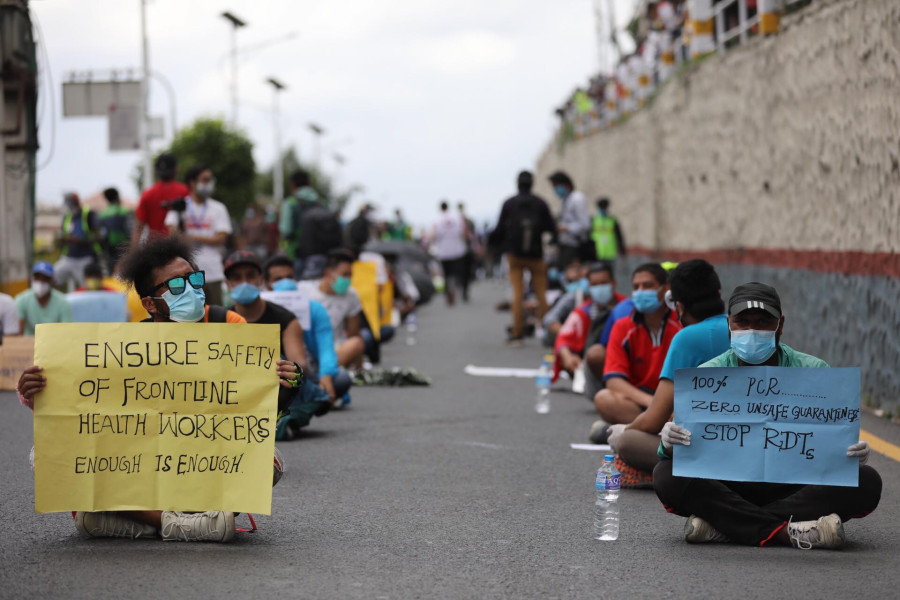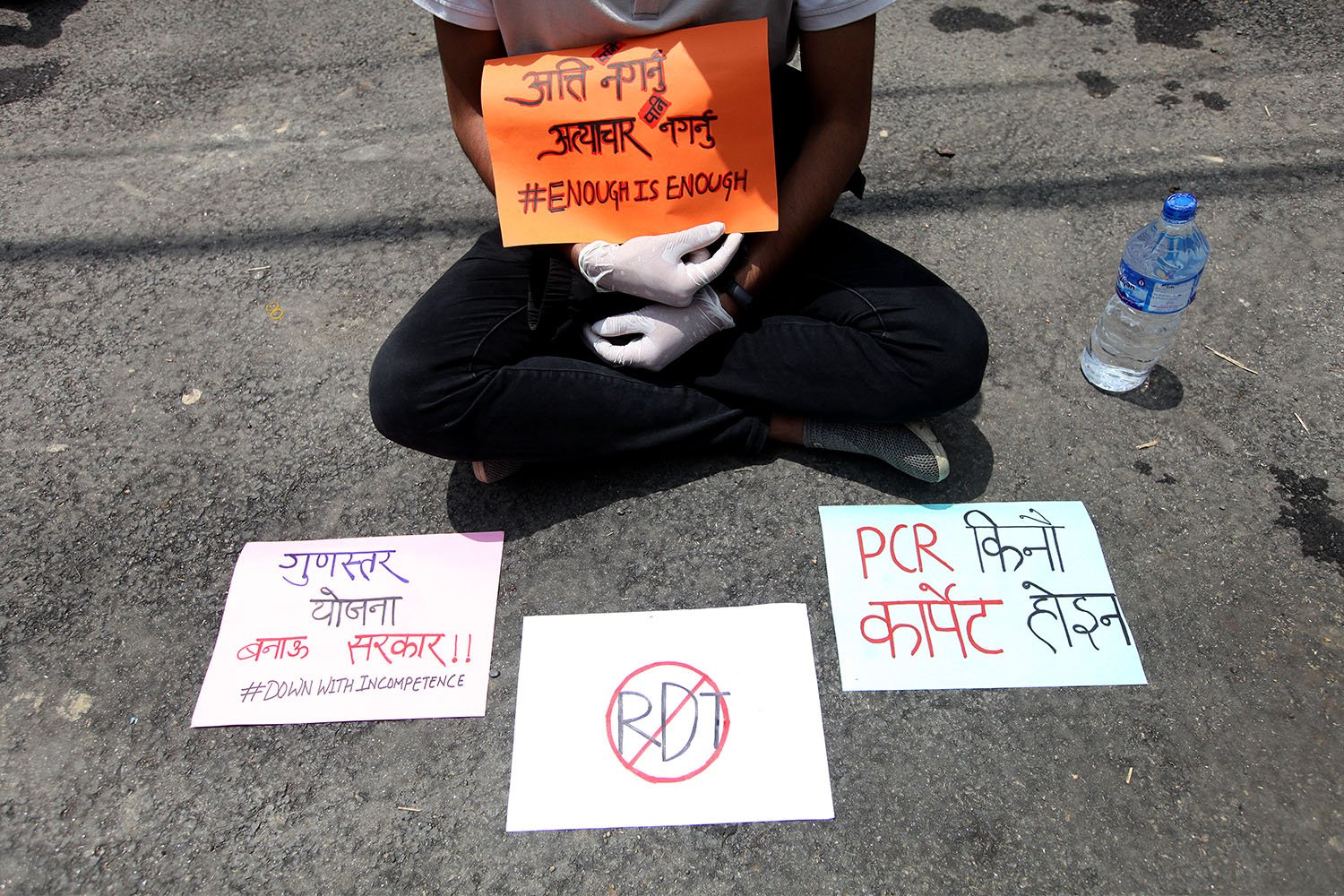National
Three youth protests in a week. Observers say government needs to take note
Politically unaffiliated youths taking to the streets is not a regular occurrence in Nepali history, say analysts, as most protests are led by political parties.
Tika R Pradhan
Three times last week, on Tuesday, Thursday and Saturday, hundreds of young people took to the streets of major cities across the country. Wearing masks, holding placards and attempting to maintain physical distance, youths in Kathmandu, Bhaktapur, Banepa, Chitwan, Hetauda, Birgunj, Pokhara, Biratnagar, Mahottari, among other cities, gathered in large numbers to protest the government’s response to the Covid-19 pandemic.
The protesters, which consist largely of politically unaffiliated youths, are taking to the streets and demanding accountability from the government, which is a rare occurrence in the history of Nepal’s public movements, say political analysts, as street protests for change have long been the province of the political parties and their sister wings.
“This is not a usual development in the country’s political history,” said Shyam Shrestha, a political analyst. “The protests against the Guthi bill have perhaps taught individuals that the government can be held accountable even without political support.”
On June 19 last year, thousands of people had gathered in the Capital to protest the government’s proposed Guthi bill, which was aimed at nationalising all guthis under a powerful commission. Newars, especially in the Kathmandu Valley, had opposed the bill as an attack on their religious and cultural heritage.
According to Shrestha, before the Guthi bill protests, most street action was led by the political parties or their youth and student wings. But the Guthi bill protests and now the youth protests show that an independent, largely politically unaffiliated protest can also get the attention of those in power, he said.
But even before the Guthi bill, one of the first large-scale, politically unaffiliated movements was perhaps the Occupy Baluwatar campaign in 2012. Organised as part of the Occupy movement that was sweeping the world that year, Occupy Baluwatar arose directly from the case of Sita Rai, a woman who was raped by a police constable upon her return from Saudi Arabia. The movement, organised largely via social media, had tackled issues of women’s safety and gender-based violence.
Like Occupy Baluwatar, last week’s protests were also organised on social media, with a Facebook group, Covid-19 Nepal: Enough is Enough, emerging as a common space for a loose group of youths with no clear leadership. Within a week, the group has amassed more than 190,000 followers. Most major political parties have informally claimed that their active membership numbers between 500,000 and 800,000.
Dates for protests are chosen and spread widely via social media. Protesters have also been sharing placards, signage and lettering online. Although some news reports have identified Ishan, who goes by Iih, as the focal point of the protests, the movement is largely leaderless and spontaneous.
“This is not a political force nor is it an organised one, but it is politically aware,” said Geja Sharma Wagle, who writes regularly on political and security issues. “These people are teaching the political forces a lesson with their creative ways of protesting.”

According to Wagle, the spontaneous outpouring shows that there exists a strong public voice against the government’s wrongdoings.
“Young people are frustrated and are mounting an unprecedented challenge to the government,” he said. “Situation could turn serious if the government fails to realise its shortcomings and tries to plot against the protesters.”
The protesters are not free of criticism. Commentators have pointed out the character of the protest—mostly young, urban, educated, middle class individuals—but analysts say that their demands don’t yet reflect an urban colour. One major demand of the protest concerns better management of quarantine facilities across the country, especially in rural areas.
“When a large number of people were suffering on the ground, the government said that it had spent Rs 10 billion on the Covid-19 response. This did not sit well with the youth,” said Bhojraj Pokhrel, a former chief election commissioner. “They then stepped out on the streets to make the government responsible, accountable and transparent.”
In early June, the government had announced that it had spent Rs9.87 billion so far on fighting Covid-19, prompting widespread disbelief. The KP Sharma Oli government has been widely criticised for failing to come up with a proper plan to deal with the pandemic despite placing the country under a lockdown for more than two months.
The protesters have also been demanding financial transparency regarding the expenditure.
While a number of political parties, including the Nepali Congress, Sajha Party, Samajbadi Party and Bibeksheel Party, have directly or indirectly supported the protests, the protesters themselves have largely remained free of political sloganeering or signage.
According to political science professor Lokraj Baral, the ongoing spontaneous protests are the result of cumulative frustrations and should serve as a wake-up call.
“Instead of two-thirds majority, what should matter more for a government are governance, delivery, transparency, integrity and how people perceive its activities,” said Baral. “This government’s credibility is nil. Youths are frustrated at the way the government is responding to the coronavirus and its failure to provide remedies.”
After meeting the first two iterations of the protest with water cannons, tear gas and batons, the Home Ministry had warned of prosecution under the Infectious Disease Act, threatening jail terms of up to six months. But on Saturday, the protests were allowed to continue and disperse on its own, although 10 people, three Nepalis and seven foreigners, were arrested. While the Nepalis have been released, six of the foreigners will be investigated and prosecuted, immigration authorities have said.
While the next date for the protest has yet to be decided, some of the protesters are considering a change in tactics, especially as the Covid-19 pandemic is still around.
Binod Deuba Thakuri, one of the moderators of the Facebook group Covid-19 Nepal: Enough is Enough, there is a risk that the government could blame them for spreading the coronavirus so they are looking to change the mode of protests. Thakuri, however, stressed that he was not a leader of the protest but was merely facilitating its organisation.
“We cannot put people at risk. We also won’t stop the protests but we will change its modality,” Thakuri told the Post.




 8.12°C Kathmandu
8.12°C Kathmandu















